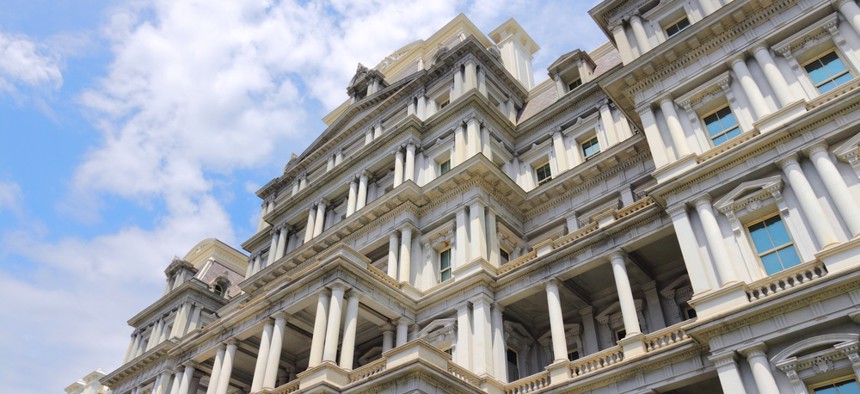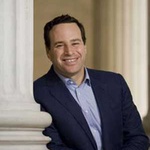
The Eisenhower Executive Office Building is shown in Washington in the spring. Tupungato/Shutterstock.com
The late Daniel Patrick Moynihan used to lament that his beloved New York City had lost the ability to get things done:
In the dear old days of Jimmy Walker, we could build the George Washington Bridge in four years and one month, and think far enough ahead to make it structurally capable of carrying a second deck when the traffic grew. When Mayor LaGuardia’s plane was forced to land in Newark because Floyd Bennett Field [New York City’s first municipal airport] was fogged in, he took out his ticket and said, “Mine says Floyd Bennett Field; what am I doing in a place called New Jersey?” Twenty-four months later, LaGuardia Airport opened.
It’s a grim but fitting irony that the New York railway terminal intended to be named in Moynihan’s honor has already fallen six years behind its scheduled 2008 opening, with no completion date in sight.
Moynihan was being sardonic when he referred to the “dear old days” of Jimmy Walker. New York’s mayor from 1926 to 1932, Walker resigned in the wake of a corruption scandal in which one of the players was found strangled to death. The point, though, was this: as bad as he was, Walker built things. The more honest government of today cannot.
Moynihan’s career coincided with many reforms of the structures and institutions of American government. Americans used to say, “You can’t fight city hall.” That was long ago. Today, there’s almost nothing a city hall might do that could not be appealed in a court somewhere.
If it cannot be argued that a city has breached a federal or state environmental law, then surely it’s committed some form of discrimination. If discrimination cannot be plausibly alleged, well, federal and state constitutions are full of words and promises that might have been violated.
We have had campaign-finance reform, and reform of the seniority system in Congress, and endless rounds of anticorruption measures in the federal government. Calls for “transparency” and “accountability” have meant more administrative and judicial supervision. In turn, power flows to impersonal institutions (agency review boards, courts, and so on) and away from elected leaders who can get things done—and who can be punished at the ballot box for delay and disappointment.
Since the 1980s, courts have become more conservative, without ceasing to be activist. They have, to take one example, persistently struck down restrictions on guns—most recently in Illinois—so that now the laws of every state in the union grant some sort of right to carry concealed weapons. Who decided that Illinois should have concealed carry? A panel of judges whose names most citizens have never heard. If things go wrong, there are few means to correct their decision, and only the most wonkish voters will know whom to blame.
And yet, when government seems to fail, Americans habitually resort to the same solutions: more process, more transparency, more appeals to courts. Each dose of this medicine leaves government more sluggish. To counter the ensuing disappointment, reformers urge yet another dose. After Speaker Tip O’Neill retired from Congress, in 1987, an interviewer asked him how the House of Representatives had changed over his 35 years of service. He memorably answered, “The people are better. The results are worse.” His answer might be generalized across the American system of government: the process is better (at least as better is conventionally defined: more transparent, more participatory), but the results are worse.
Here’s a real-world example from the executive branch. Throughout most of American history, presidents and their staffs have been able to hold confidential meetings in the White House complex. The independent counsels who investigated the Clinton White House jolted this traditional understanding by demanding—and getting—access to White House visitor logs. Thanks to these logs, investigators gained such indispensable pieces of information as the fact that Eleanor Mondale visited President Clinton alone for 40 minutes on a Sunday morning in December 1997.
The George W. Bush administration attempted to restore the traditional confidentiality of White House visitor lists. (Vice President Dick Cheney went even further, demanding that his office—not the Secret Service—keep custody of the list of all his visitors.) This attempt to restore the historical norm enraged Democrats and liberals. They accused the White House of holding “secret meetings” with energy executives. Administration foes sued to gain access to visitor logs. As a presidential candidate, Barack Obama promised to publish logs of all visitors to his White House. In office, he’s kept his word.
It hasn’t made any difference. Do you see any less lobbying in Washington? Do fewer lobbyists visit the White House? No and no. In fact, transparency is a useful tool for lobbyists—it enables them to keep better track of their competitors, and to demand equal access for themselves. The next most immediate beneficiaries of this particular policy are probably the coffee shops on Pennsylvania Avenue, where White House staffers are known to meet visitors so as to avoid generating a public record.
Reformers keep trying to eliminate backroom wheeling and dealing from American governance. What they end up doing instead is eliminating governance itself, not just in the White House but in Congress, too. Robert Caro’s biography of Lyndon Johnson tells a story that illustrates how the system used to work. Immediately upon becoming president, Johnson worked to pass President Kennedy’s stalled tax cut. He did so by wooing the chairman of the Senate Finance Committee, Harry Byrd, a conservative Virginian gripped (in Caro’s words) by a “fixation on frugality.” Byrd demanded that Johnson produce a budget of less than $100 billion. Caro details how Johnson insisted that officials in the White House’s Office of Management and Budget drive the figure down, to $97.9 billion. Byrd was satisfied; the Kennedy economic program passed.
Congress has no more Harry Byrds, single figures who can make things happen. In 1963, a committee chairman was an awesome figure. Committees could under certain circumstances convene in secret, their proceedings known only to a handful of insiders. The chairman’s power was mighty, tempered in the Senate only by the need to show courtesy to the ranking senator of the other party. House chairmen didn’t need to do even that. They had to worry only about a few other barons whose jurisdiction overlapped with their own: notably, the chairman of the Rules Committee, who wrote the “rule” that determined whether amendments to their handiwork would be allowed on the House floor. Chairmen weren’t elected. They attained their position by seniority. At which point pretty much nobody except the Angel of Death could pry away their gavels.
It was an almost crazily unrepresentative way to run a legislature! By the time a member of Congress gained a chairmanship, he was so old that he had lost touch with the country he helped govern. Harry Byrd, for example, was 76 in 1963—a man born during Grover Cleveland’s administration, trying to make sense of budgeting concepts introduced by the Keynesian revolution in economics. Johnson-era committee chairmen were drawn disproportionately from the white South, and used their power to defend racial segregation and uphold white supremacy. They were not admirable figures by any means. They harassed women, did favors for lobbyists, and got drunk during working hours. (This behavior has not disappeared from Congress, but now it’s scandalous; then, it was just how things were done.) They did pass budgets on time, however. Modern Congresses cannot be counted on to pass budgets at all.
Journalists often lament the absence of presidential leadership. What they are really observing is the weakening of congressional followership. Members of the liberal Congress elected in 1974 overturned the old committee system in an effort to weaken the power of southern conservatives. Instead—and quite inadvertently—they weakened the power of any president to move any program through any Congress. Committees and subcommittees multiplied to the point where no single chair has the power to guarantee anything. This breakdown of the committee system empowered the rank-and-file member—and provided the lobbying industry with more targets to influence. Committees now open their proceedings to the public. Many are televised. All of this allows lobbyists to keep a close eye on events—and to confirm that the politicians to whom they have contributed deliver value.
In short, in the name of “reform,” Americans over the past half century have weakened political authority. Instead of yielding more accountability, however, these reforms have yielded more lobbying, more expense, more delay, and more indecision. The irony is that Americans still think of theirs as a uniquely limited government. It isn’t.
By the International Monetary Fund’s reckoning, American government spent about 40.65 percent of the national output in 2012. That’s somewhat, but not radically, less than what Germany’s government spent (44.93 percent), only slightly less than what Canada’s spent (42.02 percent), and more than either Australia (36.4 percent) or New Zealand (34.24 percent) spent. These raw numbers overstate the difference between the United States and other countries, however. The U.S. government tends to route its subsidies through the tax code—with child tax credits and deductions for state and local taxes—rather than by issuing mother’s allowances and aid to local governments, as other countries do. This mode of doing business makes both spending and taxes look lower in the United States, even when the country is doing nearly the exact same thing as its European counterparts.
Yet somehow these spending levels don’t seem to buy as much in the United States as they do elsewhere. Health care is the obvious example: America’s per capita public expenditure on health is more than 60 percent higher than the developed-world average, and yet the U.S. ranks toward the bottom of the list on measures ranging from life expectancy to user satisfaction.
What is true of health care is true throughout federal, state, and local government: low levels of public services at high cost. It’s the story of the still-incomplete Moynihan station over and over again. For 50 years, Americans have reformed their government to allow ever more participation, ever more transparency, ever more reviews and appeals, and ever fewer actual results.
(Image via Tupungato/Shutterstock.com)







